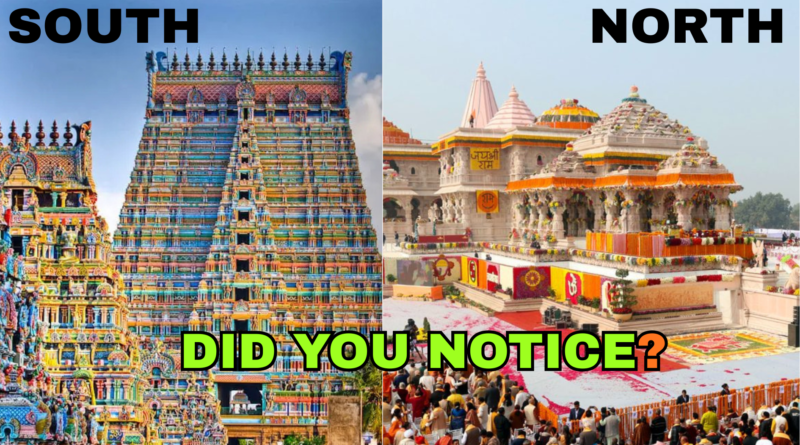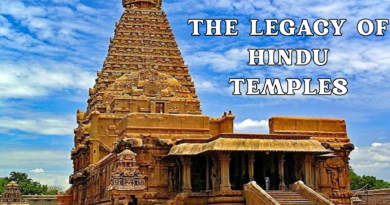WHY ARE THE SOUTH TEMPLES AND NORTH TEMPLES DIFFERENT?
The temples of South India and North India reflect two distinct architectural, cultural, and spiritual traditions that evolved over centuries. While both styles are rooted in Hindu philosophy and symbolism, their differences are shaped by regional history, climate, materials, dynasties, and rituals. Understanding why South and North Indian temples differ provides insight into the diversity and richness of India’s heritage.
1. Historical Evolution:
South Indian temple architecture evolved primarily under the patronage of powerful dynasties such as the Cholas, Pallavas, Pandyas, and Vijayanagara Empire. These dynasties fostered temple-building as a symbol of power and devotion. In contrast, North Indian temples were shaped by dynasties like the Guptas, Pratiharas, and Mughals. Frequent invasions in the North, especially by Islamic rulers, also led to the destruction or modification of many temples, influencing the evolution of architecture.
2. Architectural Style:
The two styles are known as Dravidian (South India) and Nagara (North India). Dravidian temples are typically pyramid-shaped with stepped towers known as vimanas. These towers are short but broad. On the other hand, Nagara temples feature curvilinear towers called shikharas that are tall and tapering, often resembling a mountain peak.
3. Temple Layout:
South Indian temples are often built within vast compounds with multiple enclosures (prakarams) and towering gateways called gopurams, which are usually more prominent than the main sanctum. North Indian temples, however, usually focus on the sanctum (garbhagriha) and the tower above it, with relatively smaller boundary walls and less emphasis on monumental gateways.
4. Material and Craftsmanship:
Granite and sandstone are common building materials in South Indian temples, leading to more robust, sculpturally intense structures. In North India, sandstone and marble are often used, resulting in temples with intricate carvings but comparatively lighter construction. The regional availability of materials played a major role in shaping their respective forms.
5. Sculptural Style and Iconography:
South Indian temples feature elaborate sculptures of gods, demons, animals, and scenes from epics like the Ramayana and Mahabharata carved into pillars, walls, and towers. Gopurams are particularly noted for their detailed mythological depictions. North Indian temples also have carvings, but they are generally more ornamental and less dense than in the South. The narrative elements are present but less prominent.
6. Role of Temple in Society:
In the South, temples have traditionally served as cultural hubs-centers for dance, music, education, and community gatherings. The temple economy was significant, with temples owning vast lands. North Indian temples played important spiritual and community roles but were less central to cultural performance traditions compared to South India.
7. Rituals and Worship Practices:
Though both follow core Hindu rituals, the style and format of daily worship can vary. In the South, temple rituals tend to be more rigid and deeply tied to Agama Shastras. Temples follow strict routines and the priesthood is often hereditary. North Indian temples may have slightly more relaxed formats, and the influence of regional bhakti movements has shaped practices differently.
8. Climatic Influence:
The hot and humid climate of South India influenced the architecture by necessitating high-walled enclosures and long pillared corridors that offer shade and airflow. The cooler and drier climate of many North Indian regions allowed for more compact designs, with emphasis on vertical structures rather than sprawling layouts.
9. Influence of Invasions:
Northern temples faced greater destruction during Islamic invasions, which led to a decline in temple construction during certain periods. This historical context meant many North Indian temples are newer or reconstructed. South Indian temples, especially those in Tamil Nadu, remained relatively untouched, allowing a more continuous architectural tradition.
10. Festivals and Temple Processions:
Both temple traditions celebrate festivals, but in the South, large-scale temple processions and car festivals (rathotsavas) are more prominent. Massive chariots are pulled through streets, and the temple deities are taken out in elaborate rituals. North Indian temples also have processions, but these tend to be more symbolic or localized in scale.
11. Examples of Temple Excellence:
Famous South Indian temples include the Brihadeeswarar Temple in Thanjavur, Meenakshi Temple in Madurai, and the Sri Ranganathaswamy Temple in Srirangam. North India boasts grand temples like the Kandariya Mahadeva Temple in Khajuraho, the Kashi Vishwanath Temple in Varanasi, and the Sun Temple at Konark. These temples represent the pinnacle of their respective styles.
12. Cultural Identity and Continuity:
Ultimately, the distinction between South and North Indian temples highlights the rich pluralism of Indian civilization. While sharing a common spiritual foundation, the temples reflect how regional traditions, historical events, and environmental factors shaped distinct yet equally profound expressions of devotion and artistry.




